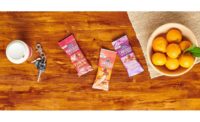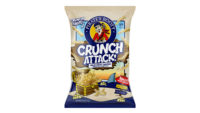ADM: Snack Attack
ADM examines the shifts--and the underlying motivations—in consumer snacking

PHOTO COURTESY OF: ADM
Times of uncertainty can have a significant impact on consumer behaviors, and the global pandemic has been a major change agent throughout the past year. The ways people snack are highly vulnerable to lifestyle shifts, more so than mealtime habits.
A recent survey shows that one out of five US consumers have changed how they snack compared to last year. On top of that, 70% of consumers say they snack on an average day(1). Plus, 35% of people report they are now snacking more often, and their reasons include managing boredom, spending more time at home, spending more time with kids, seeking comfort and managing stress(1).
Where snacking was once thought of as an indulgence or only for children, consumer perceptions have evolved over the past few decades. Now, snacking is believed to contribute to overall wellness(1).
Motivated to Munch
Of the many reasons people use to justify a snack, the main motivators are a need for nourishment, performance optimization and pleasure. People often use snacks to alleviate hunger or manage specific health issues, to fuel physical and mental performance and to fulfill emotional desires, such as indulgence, reward and discovery.
Nourishment is the leading driver and often aligns with consumer desires for nutritious snacks. One-quarter of consumers report choosing healthier snacks since the start of the pandemic, and 71% are eating fresh fruits and vegetables at least once a week(1). Consumers also are seeking nutrient-dense products high in fiber, whole grains or protein, and low fat or reduced sugar options.
Though many consumers are trying to make healthier snack choices, less intentional snacking has become more prevalent in the last year. While some level of “aimless” snacking has always been present, COVID-19 has fueled a dramatic increase in people’s need for distraction from boredom or stress. In fact, 40% of all snacking occasions reflect a need for distraction, an increase of eight percentage points from 2019(1). Additionally, snacking out of boredom has increased by four points since 20191.
A heightened focus on mental health in the last year has revealed that many people look to food, especially snacks, as a way to cope during times of anxiety and stress. Eating can create a perceived ability to manage mood and emotions, and certain flavors and brands can evoke positive memories that provide comfort.
According to Euromonitor, sales of salty snacks have risen dramatically; retailers also report a significant increase in sweet snack sales. And as the Hartman research found, 76% of consumers report having salty snacks and 70% are choosing sweet snacks at least weekly(1). Both sugary and savory snacks are perceived as comfort foods when consumers feel the need to indulge.
Generational Divides
Snacking is a dynamic consumer behavior, with a variety of consumer attitudes, approaches and needs to address. Many times, consumers will reach for a snack for a combination of reasons. Research shows that life experiences and current life stage can shape snacking motivations.
For example, snacking as a distraction from stress or boredom is most common among Gen Z and millennials, who have come of age during less certain times and often use food to cope. Gen X typically focuses on snacking for nourishment and might view indulgence as a trade-off to healthier meals. Baby boomers, on the other hand, may have more age-related health issues, but they are less inclined to use snacking as a conscious strategy to achieve health goals as they are generally more meal oriented.(1)
Millennials are an emerging “sandwich generation,” balancing work with raising children and caring for aging parents. As such, this group uses snacks for nourishment and optimization, especially to manage alertness, focus and energy. Snacking for pleasure is another big motivator, as snacks are treats for both kids and parents, and snacking is a convenient way to discover new flavors and formats. Gen Z is also more open to new experiences through snacking.(1)
Support for Holistic Health
What consumers choose to eat can either support or detract from their health and wellness goals. ADM Outside Voice℠ research finds 50% of consumers are concerned about being less active or gaining weight during the pandemic and 77% intend to make more attempts to stay healthy in the future. The snack category therefore has an opportunity to meet nutritional gaps in consumers' diets and potentially impact their overall health and well-being.
Product developers can help consumers make more intentional snack selections by creating better-for-you snacks that look and taste great. Foods and beverages (such as snack bars or shakes) that have less sugar, higher protein, and healthier fats appeal to conscious consumers of all ages.
Plant-based ingredients are another big draw, as more than 70% of consumers rate protein from plant sources as healthy(2). Ancient grains, beans, nuts and seeds are whole food ingredients that provide high nutrition, appealing textures and great taste. For example, multi-grain crackers, energy bars with nuts and seeds or puffed pea crisps can be rich in fiber, protein, vitamins and minerals and meet the desire for a satisfying salty snack.
Additionally, functional ingredients that may support metabolic health and weight management, microbiome and immune function support, increased energy and cognitive focus, cardiovascular health and more represent future growth spaces for the category. Beneficial ingredients like antioxidants or prebiotic dietary fibers, probiotics and post-biotics can be used in snack applications to increase consumer appeal.
In terms of flavors and formats, many consumers have been drawn to nostalgic snacks during the COVID-19 pandemic. These indulgences provided comfort and consistency during uncertain times. But as hope for the future increases, consumer preferences point to an ever-increasing desire to discover new and more global flavors. People are ready to delight in the unknown, and adventurous snacking is an easy way to experiment.
Manufacturers that can position their snack offerings to provide nourishment, optimization and pleasure will help consumers choose to eat and drink more intentionally.
References:
1The Hartman Group, Snacking: Emerging, Evolving and Disrupted, October 2020
2ADM Outside Voice℠
Brad Schwan is vice president, Category Marketing for ADM.
About ADM
At ADM, we unlock the power of nature to provide access to nutrition worldwide. With industry-advancing innovations, a complete portfolio of ingredients and solutions to meet any taste, and a commitment to sustainability, we give customers an edge in solving the nutritional challenges of today and tomorrow. We’re a global leader in human and animal nutrition and the world’s premier agricultural origination and processing company. Our breadth, depth, insights, facilities and logistical expertise give us unparalleled capabilities to meet needs for food, beverages, health and wellness, and more. From the seed of the idea to the outcome of the solution, we enrich the quality of life the world over.
Looking for a reprint of this article?
From high-res PDFs to custom plaques, order your copy today!





